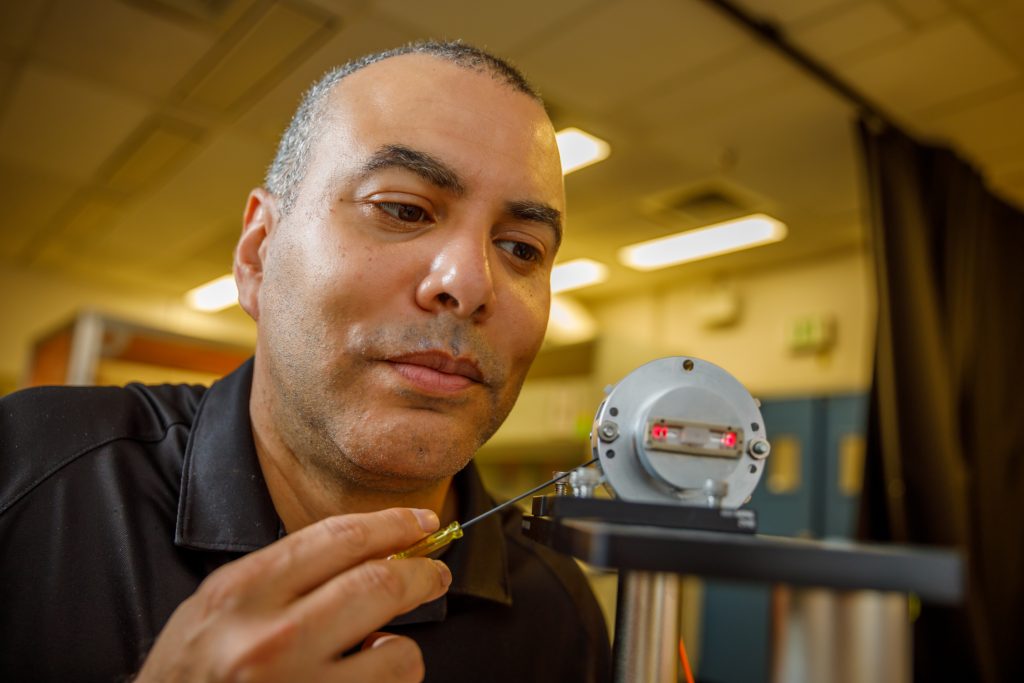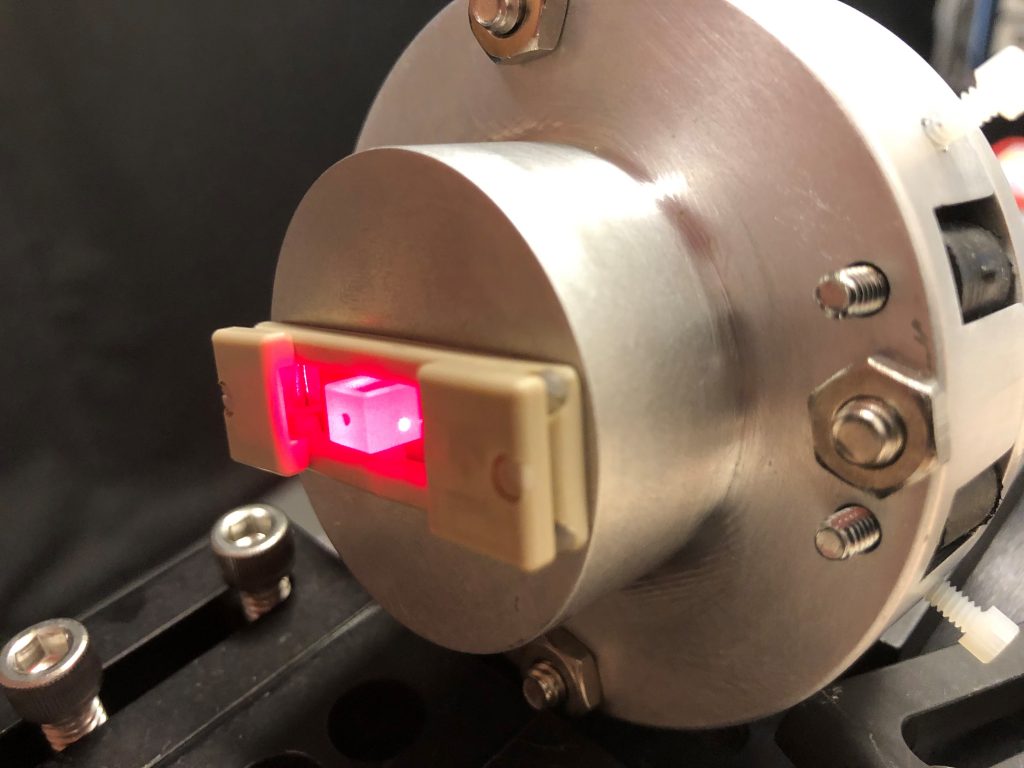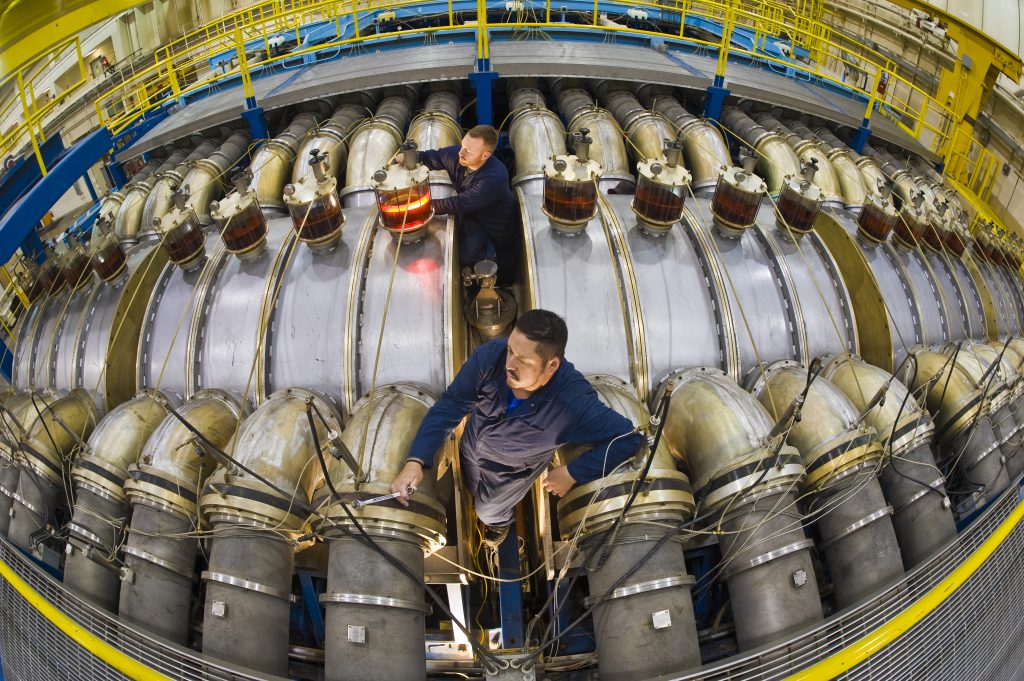Tiny crystal safely measures powerful electric fields

Ever since the first time a human placed a bare hand on an uninsulated electric line, people have refrained from personally testing energetic materials. Even meters made of metal sometimes can melt at high voltages.
Now, using a crystal smaller than a dime and a laser smaller than a shoebox, a Sandia team has safely measured 20 million volts without physically contacting the electrical flow at all. By contrast, the voltage from a home electrical outlet generally is 120 volts.
“No one had directly measured voltages this large anywhere in the world before our experiment,” said Sandia scientist Israel Owens of his team’s unique work, recently published in Nature’s Scientific Reports.
“When you have a high voltage over short distances, sensors break down,” said Sandia manager Bryan Oliver. “Israel’s diagnostic can survive these high electric fields and thus enable us to determine the voltage in an environment where that was previously not possible.”
The achievement, which multiplies every electrical field reading by the same constant to read the voltage, opens a door to a number of possible applications.
The work took place at Sandia’s High-Energy Radiation Megavolt Electron Source, or HERMES III, where the building-sized accelerator converts powerful pulses of electricity into energetic photons called gamma rays.
“Being able to measure the output voltage of Hermes III instead of only calculating it allows us to accurately define the energies of the gamma rays,” said Israel. “And our crystal-laser system does it without disturbing the measurement environment as it would if we required radioactive tools like X-rays.”
Benefits of precise generation of gamma rays

The HERMES accelerator generates a high-energy electron beam that in turn generates streams of gamma rays — the most energetic part of the electromagnetic spectrum — when passed through certain materials. These rays have a wide variety of uses, including sterilization of hospital equipment, pasteurization of food, medical imaging, smoke detectors, thickness gauges for thin materials and more.
Because nuclear weapons also generate gamma rays, creating them in a lab can determine if military and civilian structures could continue to function when exposed to those energy streams.
Accurately achieving the desired output of gamma rays requires calibration with the voltages that produced them; thus, the need for a sensor that can measure the high voltages without being destroyed.
The idea of using lasers as a remote measurement tool is not new, said Israel. Laser infrared sensors are used at a distance to safely measure forehead temperatures. Laser range finders can determine the size of a room without the owner pacing the distance.
“Our procedure is a little different: we’re not pointing the laser directly at an object to measure its voltage,” he said. “We determine that information by using our laser simply to interrogate a secondary object, a lithium niobate crystal.”
The crystal, placed where convenient for the experimenters, can remain undamaged because the electric field it measures decreases by the square of its distance from the high-voltage source.
Tiny crystals altered by huge energy fields

The crystal, less than a half-inch long, is placed so that the electrical field passes through it broadside, at right angles to the polarized laser beam traveling along the crystal’s axis.
The crystal does not allow many of the conflicting energies of the electric field to pass through it. But those that get through modify the crystal’s capability to transmit light by causing its photons to travel at different speeds in the polarized beam’s vertical and horizontal directions. This causes the polarized light to rotate, changing the amount of light entering the photodetector. The photodetector converts the laser beam’s intensity into a simple voltage that can be read on an oscilloscope.
“The voltage measured on the oscilloscope is directly related to the original applied voltage that created the intense electric field,” Israel said. “In our experiments, tens of emerging megavolts translated into hundreds of millivolts on the oscilloscope.”
(A megavolt is a million volts; a millivolt is a thousandth of a volt.)
“The signal is already in the correct form, and we just need to add in a fixed constant. There is also no need to perform any tedious calibrations or complicated post-processing to determine the electric fields and voltages,” he said.
The high voltages measured with the new sensor agreed closely with what was expected through calculations and other indirect measurements that could only infer the intensity of the emerging high voltage at HERMES, Israel said.
Accurate gamma ray production might be only one of the benefits of the new measuring technique, Israel said.
“At the moment, this is a laboratory device for research, but as its development progresses it could find its way into accelerator facilities where a series of crystals could give nanosecond voltage readings,” he said.
The technique also would work for the power transmission industry, auto manufacturers, lightning research centers “or anywhere one wants to remotely measure or monitor a very high energy source,” Israel said. The device also could “see” an electrical short in a wall from a distance due to the disruption in the electromagnetic field surrounding the current-carrying wire, which would allow non-invasive detection of a fault in the circuitry.
“For measuring most large voltages, the technique is safe, efficient and inexpensive,” he said.
The research was funded by NNSA. Other Sandia authors of the paper are Chris Grabowski, Andrew Biller, Ben Ulmen, Nathan Joseph, Ben Hughes, Sean Coffey, Debra Kirschner and Ken Struve.